How Artificial Intelligence Works
In Dentistry
From ChatGPT to advancing clinical imaging, JADA+ resource explores
the applications and science of an emerging technology
ADA’s SCDI releases new white paper on AI in dentistry
Introduction
When we think about artificial intelligence (AI), it's natural to imagine iconic characters like C-3PO from Star Wars or the lovable robot Wall-E from Pixar. These cinematic portrayals have allowed us to glimpse into a world where AI plays a central role. However, the reality is that AI has transcended the realm of science fiction and has become an integral part of our daily lives. This tech innovation is now revolutionizing the healthcare sector and is already enhancing every aspect of dentistry—from the lab to the clinic.
Imagine a patient visit to the dental chair where AI takes center stage. A quick 3D scan provides a comprehensive view of a patients’ teeth and gums, while smart glasses enable dentists to gain real-time insights into the patient's skull and teeth structure. Dental images, such as X-rays and scans, can be analyzed in seconds. Meanwhile, in the laboratory setting, AI is driving a transformative shift in the design and production of dental restorations, implants, and appliances, where precision and consistency are paramount.
Over the years, the expansion of AI in dentistry has enabled dentists to provide more personalized and effective care, leading to improved overall patient outcomes. From AI-guided imaging and precise treatment recommendations to automated workflows and personalized solutions, AI has become an indispensable tool in the dentist's arsenal. By leveraging machine- learning techniques, AI can assist to detect and classify various dental conditions, generate personalized treatment plans, and analyze data such as patient records and appointment schedules, while chatbots and virtual assistants can enhance patient interactions.
In this special series from JADA+, experts will explore the continued expansion of AI in dentistry, its numerous benefits, and the controversies ignited by its advancement, including concerns about ethics, data sets, errors, and patient privacy.
The impact of AI on dentistry has been transformative, and there are exciting possibilities for AI’s reach into areas that we can't yet fully imagine. AI is already transforming the way dentistry is taught in dental schools, preparing students for the future of dentistry. Undoubtedly, this technology is reshaping the landscape of oral healthcare today while offering a promising glimpse into the future of patient care.
As we witness the remarkable advancements and benefits AI brings to dentistry, it is essential for dental professionals to stay informed about its potential impact on their work. This series of articles will contribute to the ongoing discourse and help dental professionals develop informed perspectives.

Featured Articles
Leveraging Artificial Intelligence to Improve Clinical Success
Glidewell Dental
Four leading experts offer their perspective about the impact of AI on digital dentistry. Glidewell experts include Sergei Azernikov, Mike Selberis,...
Utilizing AI to Produce Better Crowns Faster
S. Azernikov, Ph.D.
Only a few years ago, artificial intelligence seemed like a futuristic — even fantastic — concept, but the truth is that AI has already taken root in...
The Future of Dental Practice Management: Insights Beyond Human Cognition (Why AI?)
C. Smiley, D.D.S.
Augmented intelligence (AI) is commonplace in everyday life, with predictive metrics that push content and advertisements to our social media...
Overview of Artificial Intelligence in Dentistry
M. Jurkovich, D.D.S., G. Zeller, D.D.S.
We always overestimate the change that will occur in the next two years and underestimate the change that will occur in the next ten. Don’t let...
Guest Editor's Note: Navigating This Resource on AI
R. Faiella, D.M.D., M.M.Sc., M.B.A.
Dentistry is currently experiencing significant changes in the management and delivery of treatment due to the extensive introduction and expansion...
The Ethics of Augmented Intelligence in Dentistry: Making the Patient the Priority
Michael McCarthy, Nanette Elster and Erin Williams
Over the past decade, the potential of integrating Artificial Intelligence or Augmented Intelligence (AI) as a way to assist healthcare professionals...
Panel Discussion: Exploring AI and Dental Imaging
This in-depth panel discussion addresses the emergence and application of AI in dental imaging. Panelists include Drs. Robert Faiella (moderator), Karen Panetta, Aruna Ramesh and Chris Balaban.
Slide show: How does AI assist clinicians in clinical care?
In dentistry, there are many promising clinical and business applications of AI designed to help clinicians improve dental care. This slide show illustrates a variety of AI enhancements currently available for dentists and dental care professionals.

This photo depicts a machine learning image. Because the AI algorithm can identify disease, the pink region highlights enamel and the green shading is a segmented identification that shows the clinician the extent of the decay. Some models will use a bounding box so the clinician can easily visualize decay. This AI algorithm can also help the clinician calculate decayed, missing and filled surfaces.
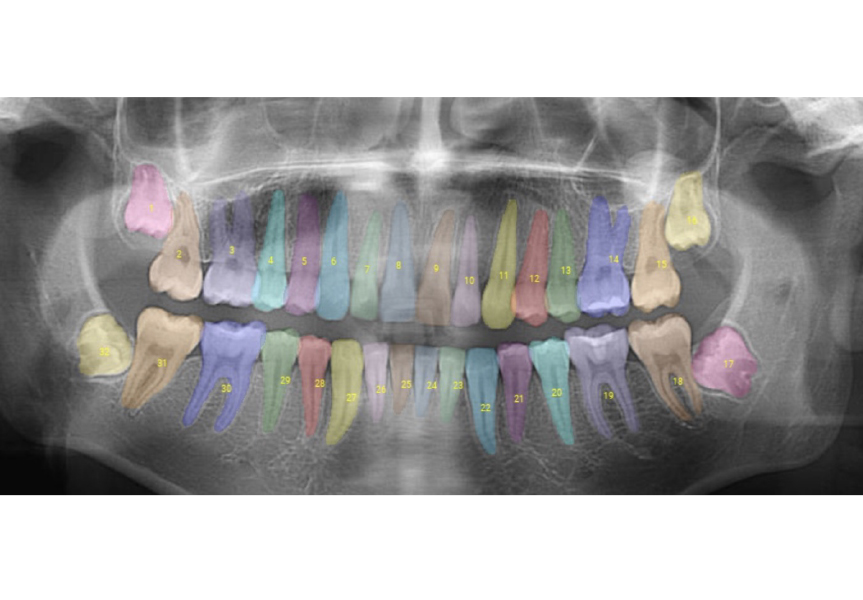
This panoramic image depicts machine learning identification of each tooth to help the clinician identify the teeth, anatomy and tooth number. With AI technology, the computer has been trained through neural network applications and millions of X-rays to aid the clinician with this kind of identification and color enhancements.
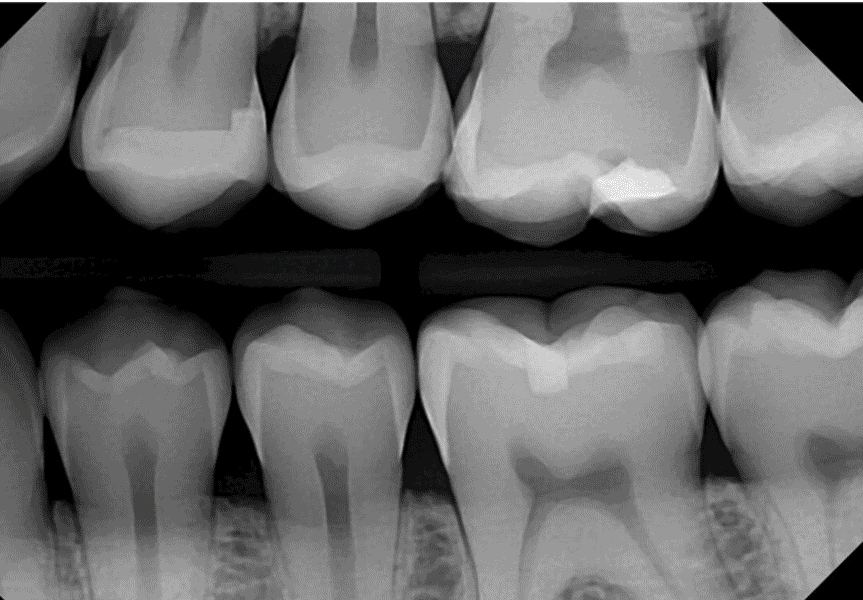
The first image in this sequence shows a standard X-ray, while the second shows the same radiograph with AI enhanced, color-coded information. The AI-enhanced image offers the clinician clear views of the enamel mask, tooth numbers, measurement from the cementoenamel junction to the crestal bone (measured to the 10th of a millimeter). Note that restorations can also be identified.

Similar to how certain tools can look at the world in infrared, UV, heat-mapping, AI algorithms have the ability to look at images in ways we as humans are unable to. These are only 4 examples of many possible AI models.

This photo depicts a sample dashboard. Not only does the AI algorithm identify images relevant for the clinician, but enhancements including bounding boxes and shading will help identify bone loss, decay or compressed margin. CEJ and crestal bone measurements also offer clinical decision support to aid diagnostic and treatment planning.

The first image shows the radiograph of a root canal, and the second AI-enhanced image identifies residual infection around the root.

To determine whether or not the root canal is well obturated, this AI-enhanced image shows the root canal fill in green and helps the clinician measure the working length (fill to the tip of the root).

This AI-enhanced radiograph identifies the crowns (dark blue), restorations (purple) and implants (far right). This image also shows tooth numbers and bone loss measurements. The AI software is flexible enough to let the clinician toggle on/off the color-enhanced functionality to aid in the diagnostic evaluation of a patient.

This image shows assessment of marginal seal around crowns, pre-cementation. Obtruation assessment and tracking of potential pathology over time is one AI benefit. We also see recurrent decay around crown margins and direct restorations. We can track incipient lesions over time following fluoride treatment and hygiene regimen.

In this radiograph, the AI-enhancements clearly show decay (green) under the enamel (pink) and through the dentin. The algorithm can also identify decay that is has not yet broken through the enamel to help the clinician decide whether remineralization is a treatment option.
More reading on AI and dentistry
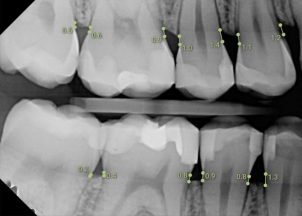
ADA White Paper offers comprehensive overview of AI
The ADA Standards Committee on Dental Informatics recently released a white paper offering dentists a comprehensive overview of artificial intelligence/augmented intelligence in dentistry.
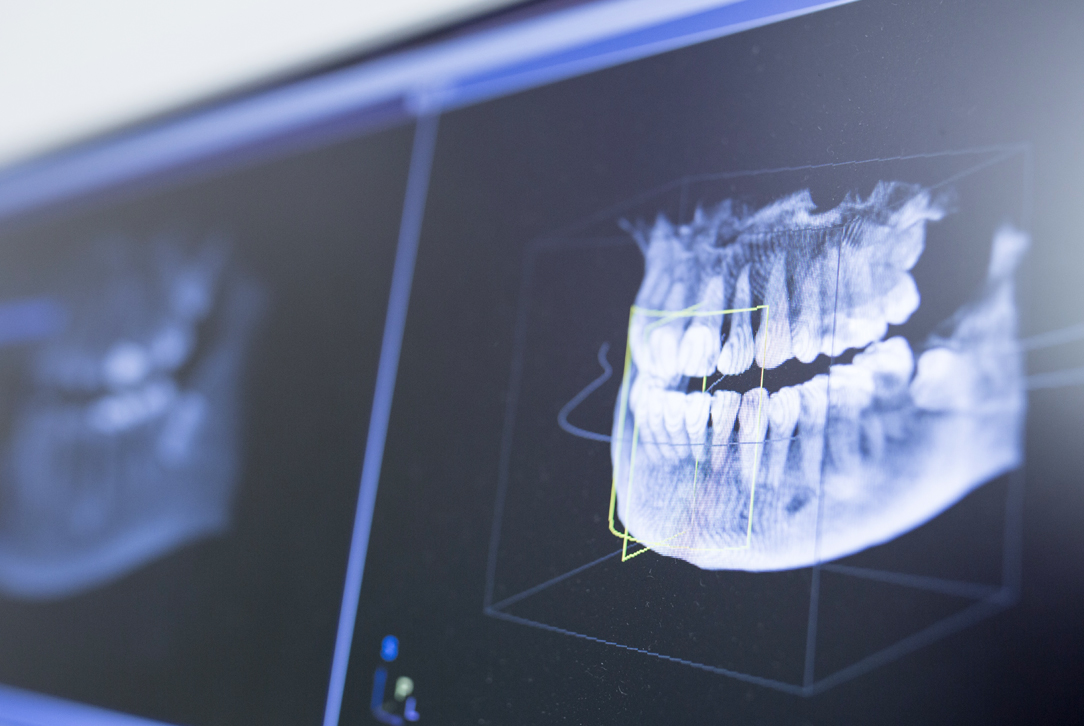
Disruptive Innovation in Dentistry: What It Is and What Could be Next
As a developing technology, artificial intelligence remains at the center of personalized dentistry which also includes dental health data, care applications, and services and operations.
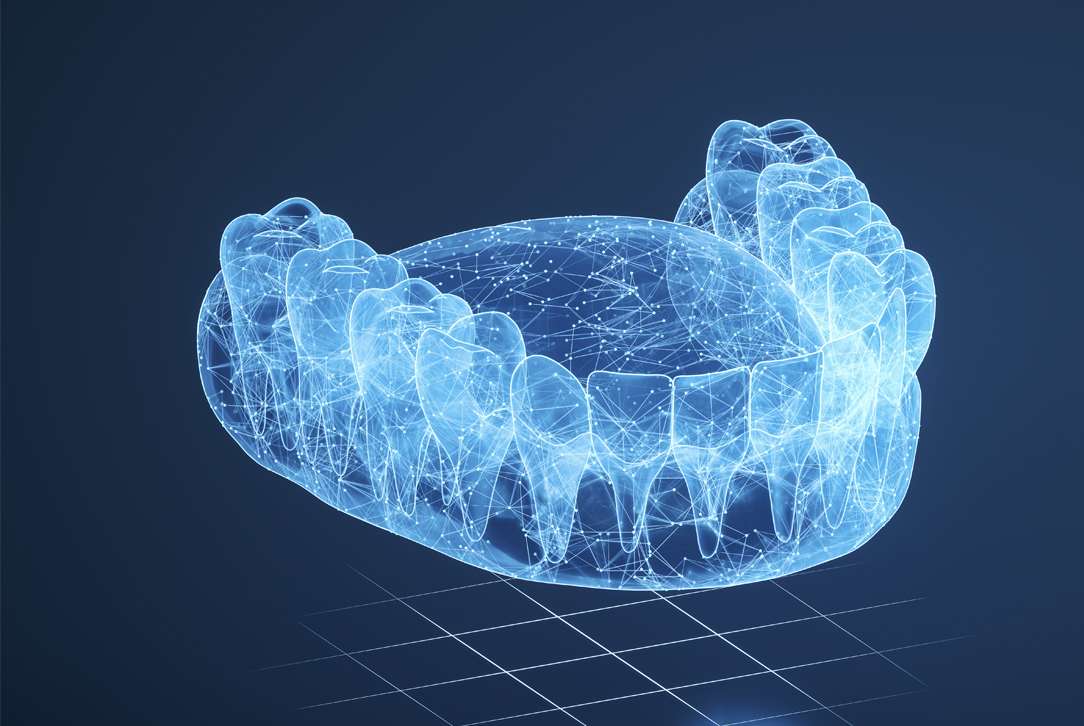
AI in Dentistry: Chances and Challenges
This article reviews artificial intelligence (AI) clinical and business applications and offers readers a glimpse at the possible future for diagnostics, image analysis, predictive modeling, records, and more.

The Emergence of AI in Dental Care Delivery
This article outlines the promise and challenges associated with the development of artificial intelligence (AI) and machine learning to help clinicians keep pace with ever-expanding medical knowledge and improve clinical intelligence in the delivery of dental care.
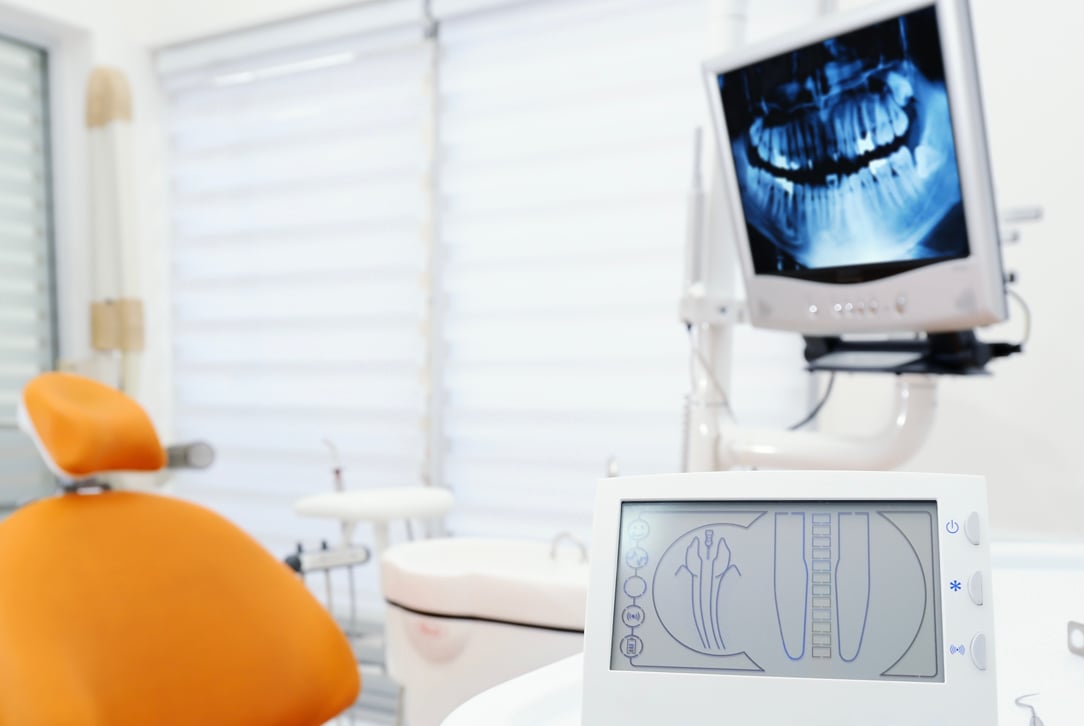
AI in Dentistry: Current Applications and Future Perspectives
Artificial intelligence (AI) is described as “a broad spectrum of emerging technologies that continue to influence daily life.” The authors explore the many ways that AI will harness big data to help enable more informed care decisions.

AI and Ethics in Dentistry: A Scoping Review
This study sought to document uses of AI in dentistry and better understand the ethical concerns posed by advancement of this technology. In total, 178 studies were retained and analyzed.
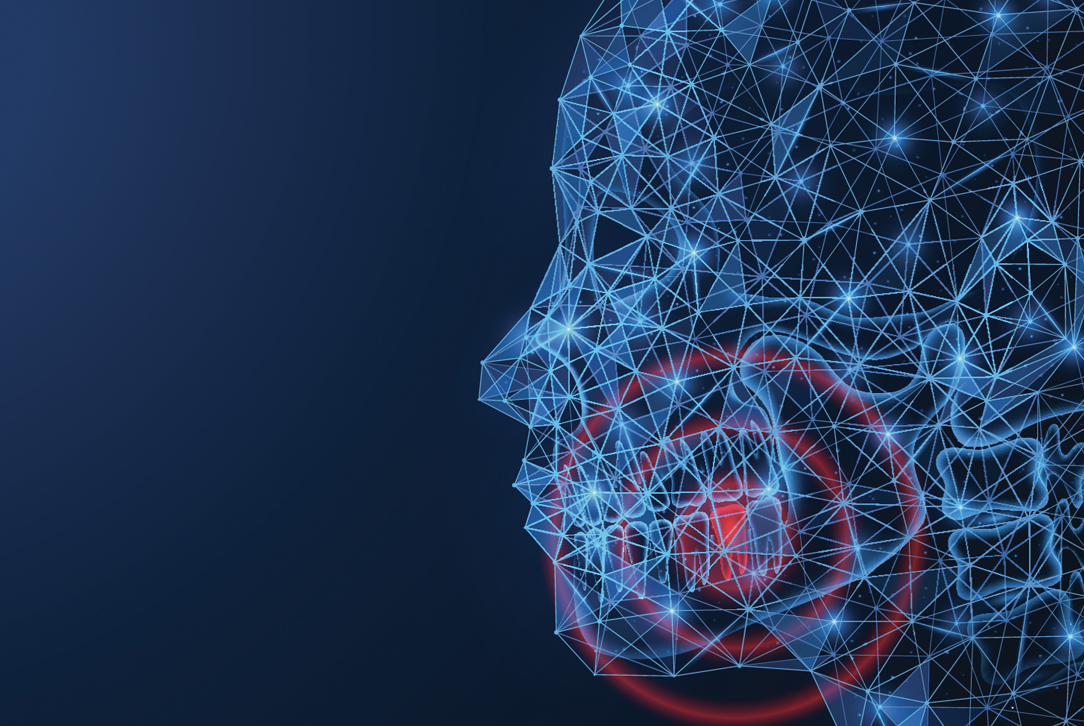
Current Applications and Development for Digital Dental Radiography
Dental radiography remains an important and "rich" area of AI development and therefore has attracted researchers to continue to develop varied applications.
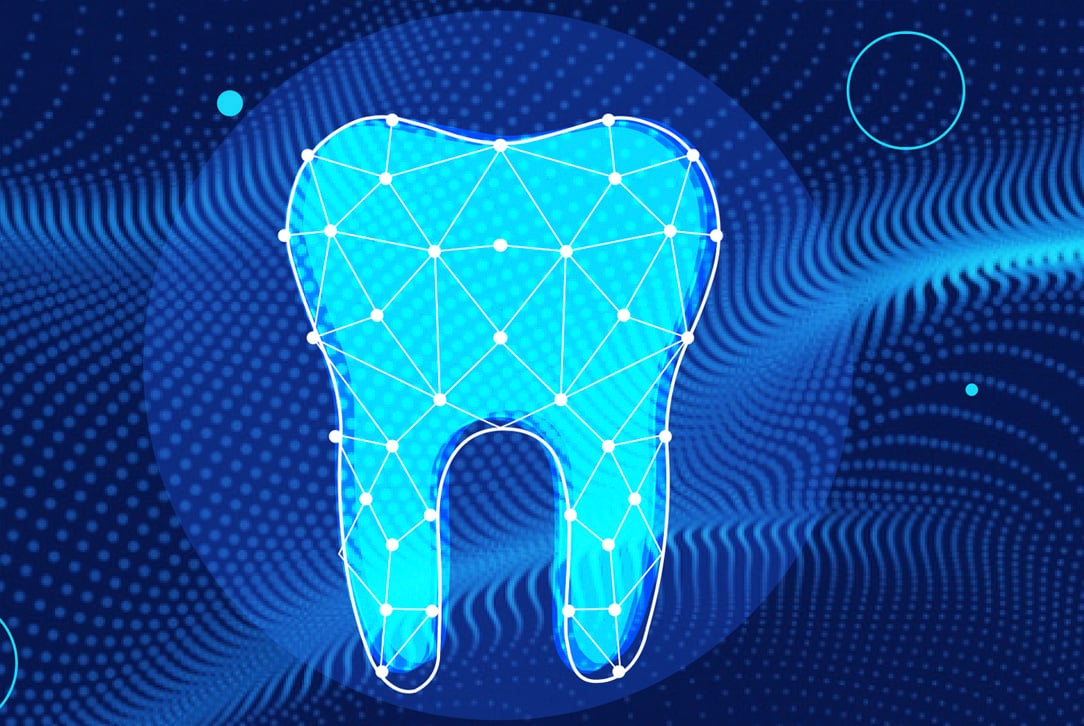
AI: The Future of Dentistry
Most AI deploys some combination of computer vision (processing and understanding digital imagery), machine learning (data-driven algorithms that enable computers to learn underlying patterns from data), and predictive analytics.
Artificial intelligence, authentic results
While AI continues to play a prominent role in our daily lives, it is transforming dentistry. Developments in both design software and intraoral scanning help to make same-day restorations a reality.

Links to More AI Resources
Applications/reviews
Reliance on AI Chatbots Such as ChatGPT in Scientific Writing
AI-Assisted Segmentation of Dental Implants on CBCT Images
Expanding the Use of AI Language Models, Such as ChatGPT, in Dental Practice
Dentistry's Digital and Connected Health Transformation
Application of AI in Dentistry
AI-Assisted Pharyngeal Airway Measurement from CBCT Data of Individuals With and Without OSA
Application of AI Deep Learning for Caries Detection
Applications of Software to Measure the Volumetric Changes of the Pulp Chamber
ADA/FDI 2021: Choosing Dental Technology That Delivers Predictable Clinical Results
AI Models for Tooth-Supported Fixed and Removable Prosthodontics
Imaging
AI Application for Generating CBCT Images From MRI
AI for Detecting Caries and Periapical Periodontitis
AI Models for Diagnosing Gingivitis and Periodontal Disease
AI-Designed Single Molar Dental Prostheses
Fully Automatic AI for Tooth and Alveolar Bone Segmentation from Cone-Beam CT Images
Neural Networks and Deep Learning
A Novel Artificial Neural Network for Diagnosing Orofacial Pain and Temporomandibular Disorders
3D Cephalometric Landmark Detection by Multiple Stage Deep Reinforcement Learning


